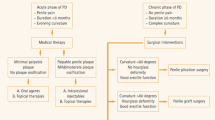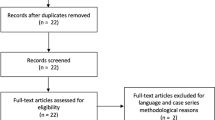Abstract
Several types of suture materials are being used for the correction of penile curvature and this study was designed to compare histopathological changes on penile tissue among different suture materials. A total of 30 male Sprague–Dawley rats were divided into five groups and right cavernosal body was sutured with 5/0 sutures (ETB: polyethylene terephthalate; PRL: polypropylene; VCR: polyglactine; and PDS: polydioxanone). An identical needle (3/8–13 mm cutting) was passed through the cavernosal bodies in the sham group (SHAM). After 3 weeks, all rats were killed and penile tissues were examined to assess the level (0–3) of inflammation, granuloma formation and fibrosis. There was a statistically significant difference among five groups regarding inflammation, granuloma formation and fibrosis levels (P<0.01 for all). The histological changes in the PRL group were not different from the SHAM group. Although the levels of granulation and fibrosis in the PDS group were also similar to the SHAM group, inflammation level was significantly higher. The inflammation, granulation and fibrosis levels were the highest in the ETB group. VCR caused similar levels of granulation and fibrosis to ETB. In conclusion, PRL suture is associated with the least histopathological change in the penile tissue. PDS can theoretically be a reasonable alternative to PRL as it causes similar levels of granulation and fibrosis.
This is a preview of subscription content, access via your institution
Access options
Subscribe to this journal
Receive 8 print issues and online access
$259.00 per year
only $32.38 per issue
Buy this article
- Purchase on Springer Link
- Instant access to full article PDF
Prices may be subject to local taxes which are calculated during checkout

Similar content being viewed by others
References
Yachia D, Beyar M, Aridogan IA, Dascalu S . The incidence of congenital penile curvature. J Urol 1993; 150: 1478–1479.
Schwarzer U, Sommer F, Klotz T, Braun M, Reifenrath B, Engelmann U . The prevalence of Peyronie’s disease: results of a large survey. BJU Int 2001; 88: 727–730.
Mulhall JP, Creech SD, Boorjian SA, Ghaly S, Kim ED, Moty A . Subjective and objective analysis of the prevalence of Peyronie’s disease in a population of men presenting for prostate cancer screening. J Urol 2004; 171: 2350–2353.
Serefoglu EC, Hellstrom WJ . Treatment of Peyronie’s disease: 2012 update. Curr Urol Rep 2011; 12: 444–452.
Nesbit RM . Congenital curvature of the phallus: report of three cases with description of corrective operation. J Urol 1965; 93: 230–232.
Yachia D . Modified corporoplasty for the treatment of penile curvature. J Urol 1990; 143: 80–82.
Essed E, Schroeder FH . New surgical treatment for Peyronie disease. Urology 1985; 25: 582–587.
Gholami SS, Lue TF . Correction of penile curvature using the 16-dot plication technique: a review of 132 patients. J Urol 2002; 167: 2066–2069.
Mobley EM, Fuchs ME, Myers JB, Brant WO . Update on plication procedures for Peyronie’s disease and other penile deformities. Ther Adv Urol 2012; 4: 335–346.
Hsieh JT, Huang HE, Chen J, Chang HC, Liu SP . Modified plication of the tunica albuginea in treating congenital penile curvature. BJU Int 2001; 88: 236–240.
Hsieh JT, Liu SP, Chen Y, Chang HC, Yu HJ, Chen CH . Correction of congenital penile curvature using modified tunical plication with absorbable sutures: the long-term outcome and patient satisfaction. Eur Urol 2007; 52: 261–266.
Anderson ET, Davis AS, Law JM, Lewbart GA, Christian LS, Harms CA . Gross and histologic evaluation of 5 suture materials in the skin and subcutaneous tissue of the California sea hare (Aplysia californica). J Am Assoc Lab Anim Sci 2010; 49: 64–68.
Nary Filho H, Matsumoto MA, Batista AC, Lopes LC, de Góes FC, Consolaro A . Comparative study of tissue response to polyglecaprone 25, polyglactin 910 and polytetrafluorethylene suture materials in rats. Braz Dent J 2002; 13: 86–91.
Nesbit RM . Congenital curvature of the phallus: report of three cases with description of corrective operation. Trans Am Assoc Genitourin Surg 1964; 56: 20–22.
Pryor JP, Fitzpatrick JM . A new approach to the correction of the penile deformity in Peyronie’s disease. J Urol 1979; 122: 622–623.
Giammusso B, Burrello M, Branchina A, Nicolosi F, Motta M . Modified corporoplasty for ventral penile curvature: description of the technique and initial results. J Urol 2004; 171: 1209–1211.
Daitch JA, Angermeier KW, Montague DK . Modified corporoplasty for penile curvature: long-term results and patient satisfaction. J Urol 1999; 162: 2006–2009.
Popken G, Wetterauer U, Schultze-Seemann W, Deckart AB, Sommerkamp H . A modified corporoplasty for treating congenital penile curvature and reducing the incidence of palpable indurations. BJU Int 1999; 83: 71–75.
Sassine AM, Wespes E, Schulman CC . Modified corporoplasty for penile curvature: 10 years’ experience. Urology 1994; 44: 419–421.
Sumpio BE, Widmann MD . Enhanced production of endothelium-derived contracting factor by endothelial cells subjected to pulsatile stretch. Surgery 1990; 108: 277–281, discussion 281–282.
Oguma J, Ozawa S, Morikawa Y, Furukawa T, Kitagawa Y, Ueda M et al. Knot-tying force during suturing and wound healing in the gastrointestinal tract. J Surg Res 2007; 140: 129–134.
Shirazi M, Noorafshan A, Serhan A . Effects of different suture materials used for the repair of hypospadias: a stereological study in a rat model. Urol Int 2012; 89: 395–401.
Baskin LS, Lue TF . The correction of congenital penile curvature in young men. Br J Urol 1998; 81: 895–899.
Thiounn N, Missirliu A, Zerbib M, Larrouy M, Dje K, Flam T et al. Corporeal plication for surgical correction of penile curvature. Experience with 60 patients. Eur Urol 1998; 33: 401–404.
Chien GW, Aboseif SR . Corporeal plication for the treatment of congenital penile curvature. J Urol 2003; 169: 599–602.
Van Der Horst C, Martinez Portillo FJ, Seif C, Alken P, Juenemann KP . Treatment of penile curvature with Essed-Schroder tunical plication: aspects of quality of life from the patients’ perspective. BJU Int 2004; 93: 105–108.
Poulsen J, Kirkeby HJ . Treatment of penile curvature—a retrospective study of 175 patients operated with plication of the tunica albuginea or with the Nesbit procedure. Br J Urol 1995; 75: 370–374.
Basiri A, Sarhangnejad R, Ghahestani SM, Radfar MH . Comparing absorbable and nonabsorbable sutures in corporeal plication for treatment of congenital penile curvature. Urol J 2011; 8: 302–306.
Author information
Authors and Affiliations
Corresponding author
Ethics declarations
Competing interests
The authors declare no conflict of interest.
Rights and permissions
About this article
Cite this article
Tuken, M., Altinay, S., Temiz, M. et al. The effects of four different suture materials on penile tissue of rats. Int J Impot Res 28, 50–53 (2016). https://doi.org/10.1038/ijir.2015.32
Received:
Revised:
Accepted:
Published:
Issue Date:
DOI: https://doi.org/10.1038/ijir.2015.32



